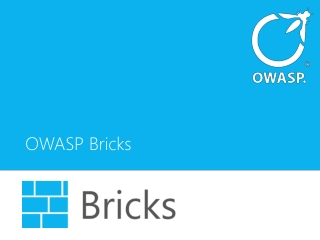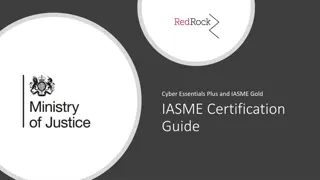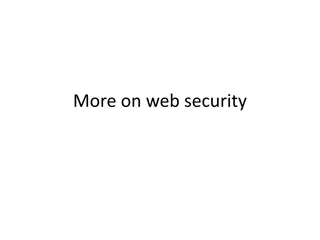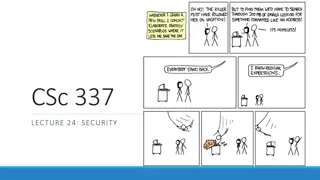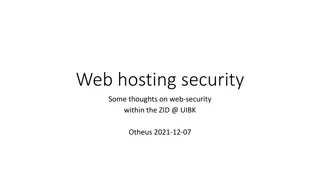
Web Security Essentials
Safeguarding websites, servers, and data from unauthorized access is crucial. This presentation covers key topics like web architecture, web servers (Apache, Nginx), HTTP protocol, requests and responses, and the importance of session cookies. Understanding these fundamental concepts is vital for ensuring a secure web environment.
Download Presentation

Please find below an Image/Link to download the presentation.
The content on the website is provided AS IS for your information and personal use only. It may not be sold, licensed, or shared on other websites without obtaining consent from the author. If you encounter any issues during the download, it is possible that the publisher has removed the file from their server.
You are allowed to download the files provided on this website for personal or commercial use, subject to the condition that they are used lawfully. All files are the property of their respective owners.
The content on the website is provided AS IS for your information and personal use only. It may not be sold, licensed, or shared on other websites without obtaining consent from the author.
E N D
Presentation Transcript
Omar Mohamed Web Security
INTRODUCTION Web security involves protecting websites, servers, and data from unauthorized access and breaches. Key Concepts Covered in this presentation: 1. Web Architecture 2. Web Servers: Apache and Nginx 3. HTTP Protocol 4. HTTP Requests and Responses 5. Session and Cookies
Web Architecture Client: User's device (computer, smartphone, tablet) Browser: Software to interpret and display web pages (Chrome, Firefox, Safari) Server: Computer that stores and serves web content Web Server: Software on the server that handles requests and sends responses (Apache, Nginx)
WEB SEVERS A web server is software or hardware that serves web content. Apache: Open-source, widely used Highly configurable Supports various modules for security, performance, and more Nginx: High-performance, efficient Often used as a reverse proxy or load balancer Strong security features
HTTP Protocols HTTP (HyperText Transfer Protocol): Foundation of web communication. Common HTTP Methods: GET: Retrieve data. POST: Submit data. PUT: Update data. DELETE: Remove data. HTTPS: Secure version of HTTP using SSL/TLS encryption. Importance: Prevents data interception. Ensures data integrity and authenticity
HTTP Requests and Responses HTTP Request Structure: 1. Request Line: Method, URL, and HTTP version. 2. Headers: Metadata (e.g., User-Agent, Content-Type). 3. Body: Data sent to the server (e.g., form submissions). HTTP Response Structure: 1. Status Line: HTTP version and status code (e.g., 200, 404). 2. Headers: Metadata (e.g., Content-Type). 3. Body: Content returned to the client. Common Status Codes: 1. 200 OK: Request succeeded. 2. 404 Not Found: Resource not found. 3. 500 Internal Server Error: Server-side issue
COOKIES Cookies are small text files stored on the client-side by websites. Types: Session Cookies: Temporary, deleted after the session ends. Persistent Cookies: Stored until a specified expiration date. Usage: Session management (e.g., logins). Personalization (e.g., themes). Tracking user behavior. Security: Use HTTP-Only and Secure flags. Regularly validate cookie content.
Session You can store user information (e.g. username, items selected, etc.) in the server side for later use using PHP session. Sessions work by creating a unique id (UID) For each visitor and storing variables based on this UID. The UID is either stored in a cookie or is propagated in the URL. Starting a PHP session: <?php session_start(); ?>
How Do Sessions Work? 1. User initiates interaction with the web application. 2. Server creates a session and generates a unique Session ID. 3. Session ID is sent to the client, typically stored in a cookie. 4. Client sends the Session ID with subsequent requests. 5. Server uses the Session ID to retrieve stored session data.
Use Cases and Best Practices Cookies: Remember user preferences and settings. Implement "Remember Me" functionality. Track user behavior for analytics. Sessions: Manage user authentication and authorization. Store temporary data like shopping cart contents. Best Practices: Use Secure and HttpOnly flags for cookies containing sensitive information. Regularly regenerate Session IDs to prevent fixation attacks. Implement proper session timeout and cleanup mechanisms.
Security Implications Common Vulnerabilities: - Unsecured cookies. - Improper server configurations. - Open redirects. - Best Practices: - Use HTTPS to encrypt communications. - Sanitize and validate all inputs. - Configure secure HTTP headers (e.g., Content-Security-Policy).
Tools for Securing Web Basics Web Application Firewalls (WAFs): Protect against common threats. SSL/TLS Certificates: Secure web communications. Vulnerability Scanners: Detect potential flaws in web applications. Logging and Monitoring Tools: Track and respond to anomalies.


